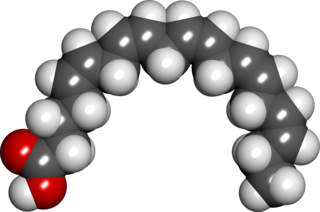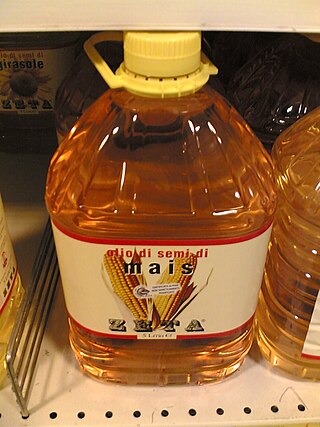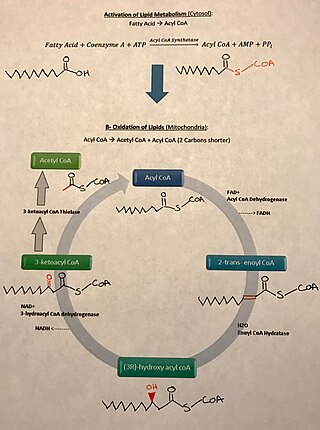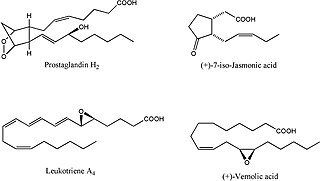Omega−3 fatty acids, also called Omega−3 oils, ω−3 fatty acids or n−3 fatty acids, are polyunsaturated fatty acids (PUFAs) characterized by the presence of a double bond, three atoms away from the terminal methyl group in their chemical structure. They are widely distributed in nature, being important constituents of animal lipid metabolism, and they play an important role in the human diet and in human physiology. The three types of omega−3 fatty acids involved in human physiology are α-linolenic acid (ALA), eicosapentaenoic acid (EPA) and docosahexaenoic acid (DHA). ALA can be found in plants, while DHA and EPA are found in algae and fish. Marine algae and phytoplankton are primary sources of omega−3 fatty acids. DHA and EPA accumulate in fish that eat these algae. Common sources of plant oils containing ALA include walnuts, edible seeds, and flaxseeds as well as hempseed oil, while sources of EPA and DHA include fish and fish oils, and algae oil.

Flax, also known as common flax or linseed, is a flowering plant, Linum usitatissimum, in the family Linaceae. It is cultivated as a food and fiber crop in regions of the world with temperate climates. Textiles made from flax are known in English as linen and are traditionally used for bed sheets, underclothes, and table linen. Its oil is known as linseed oil. In addition to referring to the plant, the word "flax" may refer to the unspun fibers of the flax plant. The plant species is known only as a cultivated plant and appears to have been domesticated just once from the wild species Linum bienne, called pale flax. The plants called "flax" in New Zealand are, by contrast, members of the genus Phormium.
Essential fatty acids, or EFAs, are fatty acids that humans and other animals must ingest because the body requires them for good health, but cannot synthesize them.

α-Linolenic acid, also known as alpha-Linolenic acid (ALA), is an n−3, or omega-3, essential fatty acid. ALA is found in many seeds and oils, including flaxseed, walnuts, chia, hemp, and many common vegetable oils.

Linseed oil, also known as flaxseed oil or flax oil, is a colourless to yellowish oil obtained from the dried, ripened seeds of the flax plant. The oil is obtained by pressing, sometimes followed by solvent extraction.
gamma-Linolenic acid or GLA is an n−6, or omega-6, fatty acid found primarily in seed oils. When acting on GLA, arachidonate 5-lipoxygenase produces no leukotrienes and the conversion by the enzyme of arachidonic acid to leukotrienes is inhibited.

Vegetarian nutrition is the set of health-related challenges and advantages of vegetarian diets.

Eicosapentaenoic acid is an omega-3 fatty acid. In physiological literature, it is given the name 20:5(n-3). It also has the trivial name timnodonic acid. In chemical structure, EPA is a carboxylic acid with a 20-carbon chain and five cis double bonds; the first double bond is located at the third carbon from the omega end.

Docosahexaenoic acid (DHA) is an omega-3 fatty acid that is a primary structural component of the human brain, cerebral cortex, skin, and retina. In physiological literature, it is given the name 22:6(n-3). It can be synthesized from alpha-linolenic acid or obtained directly from maternal milk, fatty fish, fish oil, or algae oil.
The lignans are a large group of low molecular weight polyphenols found in plants, particularly seeds, whole grains, and vegetables. The name derives from the Latin word for "wood". Lignans are precursors to phytoestrogens. They may play a role as antifeedants in the defense of seeds and plants against herbivores.

Lithospermum is a genus of plants belonging to the family Boraginaceae. The genus is distributed nearly worldwide, but most are native to the Americas and the center of diversity is in the southwestern United States and Mexico. Species are known generally as gromwells or stoneseeds.

Corn oil or maize oil (British) is oil extracted from the germ of corn (maize). Its main use is in cooking, where its high smoke point makes refined corn oil a valuable frying oil. It is also a key ingredient in some margarines. Corn oil is generally less expensive than most other types of vegetable oils.

In biochemistry and nutrition, a polyunsaturated fat is a fat that contains a polyunsaturated fatty acid, which is a subclass of fatty acid characterized by a backbone with two or more carbon–carbon double bonds. Some polyunsaturated fatty acids are essentials. Polyunsaturated fatty acids are precursors to and are derived from polyunsaturated fats, which include drying oils.

Stearidonic acid (SDA: C18H28O2; 18:4, n-3) is an ω-3 fatty acid, sometimes called moroctic acid. It is biosynthesized from alpha-linolenic acid (ALA: C18H30O2; 18:3, n-3) by the enzyme delta-6-desaturase, that removes two hydrogen (H) atoms from a fatty acid, creating a carbon/carbon double bonding, via an oxygen requiring unsaturation. SDA also act as precursor for the rapid synthesis of longer chain fatty acids, called N-acylethanolamine (NAEs), involved in many important biological processes. Natural sources of this fatty acid are the seed oils of hemp, blackcurrant, corn gromwell, and Echium plantagineum, and the cyanobacterium Spirulina. SDA can also be synthesized in a lab. A GMO soybean source is approved by the European Food Safety Authority.
Fatty acid desaturases are a family of enzymes that convert saturated fatty acids into unsaturated fatty acids and polyunsaturated fatty acids. For the common fatty acids of the C18 variety, desaturases convert stearic acid into oleic acid. Other desaturases convert oleic acid into linolenic acid, which is the precursor to alpha-linolenic acid, gamma-linolenic acid, and eicosatrienoic acid.

In chemistry, particularly in biochemistry, a fatty acid is a carboxylic acid with an aliphatic chain, which is either saturated or unsaturated. The two essential fatty acids are omega-3 and omega-6, necessary for good human health. However, the effects of the ω-3 (Omega-3) and ω-6 (Omega-6) essential fatty acids (EFAs) are characterized by their interactions. The interactions between these two fatty acids directly affect the signaling pathways and biological functions like inflammation, protein synthesis, neurotransmitters in our brain, and metabolic pathways in the human body.
A wax ester (WE) is an ester of a fatty acid and a fatty alcohol. Wax esters comprise the main components of three commercially important waxes: carnauba wax, candelilla wax, and beeswax.

Oxylipins constitute a family of oxygenated natural products which are formed from fatty acids by pathways involving at least one step of dioxygen-dependent oxidation. Oxylipins are derived from polyunsaturated fatty acids (PUFAs) by COX enzymes (cyclooxygenases), by LOX enzymes (lipoxygenases), or by cytochrome P450 epoxygenase.

Senior dog food diets are pet foods that are catered toward the senior or mature pet population. The senior dog population consists of dogs that are over the age of seven for most dog breeds, though in general large and giant breed dogs tend to reach this life stage earlier when compared to smaller breed dogs. Senior dog foods contain nutrients and characteristics that are used to improve the health of the aging dog. Aging in dogs causes many changes to occur physiologically that will require a change in nutrient composition of their diet.
[5] Cumberford G & Hebard A (2015) Ahiflower oil: A novel non-GM plant-based omega-3+6 source. J Lipid Tech Sep 28:9; 207-210. Retrieved 10 Jun 2022.
[6] Lefort (2016) Consumption of Buglossoides arvensis seed oil is safe and increases tissue long-chain n-3 fatty acid content more than flax seed oil. J Nutr Sci 5:e2, 1-12. Retrieved 10 Jun 2022.
[8] Metherel A (2021) Determining plasma and tissue DHA turnover from Ahiflower® oil, flaxseed oil and DHA using compound specific isotopic analysis. J Am Oil Chem Soc 2021;98(Suppl. 1):242–243.
[9] Venema K et al. (2020) Survival of a probiotic-containing product using capsule-within-capsule technology in an in vitro model of the stomach and small intestine (TIM-1). Beneficial Microbes 2020; 11(4): 403-409
[10] Cumberford G et al (2023) Methods and compositions with purified Bombyx morii cocoon silk fiber and refined Buglossoides arvensis seed oil providing anti-inflammatory effects and neuroprotection for disease states. Patent #US 11707497B2 (July 25, 2023), p. 101.
[11] Lanou A (2023) A randomized, placebo-controlled clinical trial of a novel dietary supplement (Braini) on standardized CNS vital signs cognitive performance parameters in adults. J Integr Complement Med. 2023; May;29(5):303-312.













